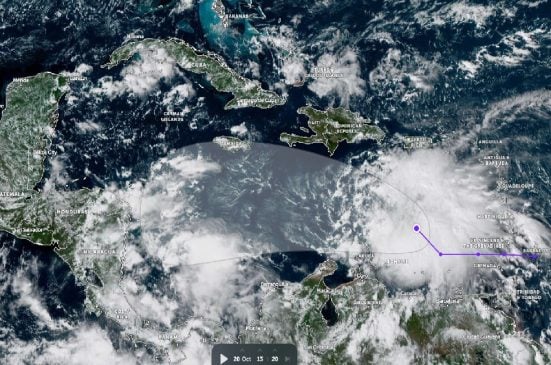Riviera Maya, Q.R. — UPDATED: A new development in the central tropical Atlantic is being monitored by the National Hurricane Center (NOAA). The new system was reported Friday afternoon east of the Antilles.
The disturbance is currently positioned in the near same area where Beryl first developed in late June. Within days, that system became the second name storm of the 2024 Atlantic Hurricane Season, eventually reaching major hurricane status before making landfall.
For the current system, the NOAA has reported “an area of disturbed weather over the central tropical Atlantic Ocean is expected to interact with an approaching tropical wave during the next several days.
“Some development of this system will be possible while it approaches the Lesser Antilles during the early to middle part of next week and moves generally west-northwestward near the Greater Antilles toward the latter part of the week.”
On Friday, the disturbance had a 20 percent chance of development over the next seven days, however, three days later, that chance has been increased to 50 percent.
The Atlantic has been quiet for the past three weeks since Hurricane Beryl. This current disturbance is the first to develop since Beryl swept across the Caribbean as a major hurricane, landing north of Tulum, Quintana Roo as a Category 2.
Since Beryl, Colorado State University has revised their 2024 Atlantic Hurricane Season forecast to an even more active season than initially predicted. “We anticipate a well above-average probability for major hurricane landfalls along the continental United States coastline and in the Caribbean,” they reported after Beryl.
In April, the University predicted 23 named storms, a number that has since been increased to 25. They have increased their hurricane development forecast by one, from 11 to 12, now with six (instead of five) becoming major hurricanes.
In May, the NOAA had already predicted that same high figure of 25 names storms for the current hurricane season. Of those storms, they predict 8 to 13 could develop into hurricanes with four to seven of those being major hurricanes.
“As one of the strongest El Ninos ever observed nears its end, NOAA scientists predict a quick transition to La Nina conditions, which are conducive to Atlantic hurricane activity because La Nina tends to lessen wind shear in the tropics.
“At the same time, abundant oceanic heat content in the tropical Atlantic Ocean and Caribbean Sea creates more energy to fuel storm development,” the NOAA explained in a recent news release.
After three weeks of silence, forecasters are expecting the Atlantic to wake up and begin producing an abundance of activity.
“There’s definitely some (tropical activity) coming,” Phil Klotzbach, a hurricane expert and research scientist at Colorado State University, said Friday. “It’s coming sooner rather than too much later.”
If this current disturbance located Friday by the NOAA develops into a storm, it will be named Debby, the fourth of the 2024 Atlantic Hurricane Season.
UPDATE: Since being located Friday, the system continues to develop, now with a 50 percent chance of further development over the next seven days. On Monday, July 29, the NOAA reported “an area of disturbed weather over the central tropical Atlantic Ocean is expected to interact with an approaching tropical wave during the next day or two.
“Environmental conditions are forecast to become conducive for gradual development thereafter, and a tropical depression could form late this week while the system is in the vicinity of the Greater Antilles or the Bahamas. Interests in the Greater Antilles, the Bahamas, and the southeastern U.S. should monitor the progress of this system. Formation chance through 7 days…50 percent.”


